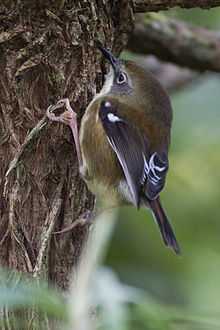Scrubtit
| Scrubtit | |
|---|---|
 | |
| Conservation status | |
| Scientific classification | |
| Kingdom: | Animalia |
| Phylum: | Chordata |
| Class: | Aves |
| Order: | Passeriformes |
| Family: | Acanthizidae |
| Genus: | Acanthornis Legge, 1887 |
| Species: | A. magna |
| Binomial name | |
| Acanthornis magna (Gould, 1855) | |
| Synonyms | |
|
Acanthornis magnus | |
The scrubtit (Acanthornis magna) is a species of bird in the thornbill family Acanthizidae. It is monotypic within the genus Acanthornis,[2] and is endemic to Tasmania and King Island in Australia. Its natural habitat is the temperate rainforest, Nothofagus beech forest and eucalypt woodland. It is a small species that resembles the Sericornis scrubwrens (with which is was once placed).
The scrubtit is 11 to 12 centimetres (4.33 to 4.72 in) long and weighs around 10 grams (0.35 oz). The plumage consists of a white throat and belly, a brown back, crown, flank and tail, black wings and grey on the face. The eye is pale and the bill is short, black and slightly curved. The species is often silent but makes quite contact calls and has a song described as "sweet [and] musical".
The scrubtit forages individually, in pairs or in small family groups near the ground in dense cover. It feeds on small invertebrates, particularly insects and their eggs. The species will associate with mixed-species feeding flocks. The species is territorial and monogamous, with the breeding season lasting from September to January. The nest is a weaved globe with a side entrance, lined with feathers and fur, camouflaged and usually found between 1–3 m off the ground. The clutch size is usually three eggs but sometimes four, although no information exists about incubation or nestling times. Both parents feed the chicks in the nest, but unlike many Australian passerines helpers have never been reported.[3] The species is victim to brood parasitism by fan-tailed cuckoos and shining bronze cuckoos, and quolls also take eggs and nestlings.
The species has a restricted range but is not considered threatened by the IUCN. The subspecies found on King Island is considered critically endangered however. The species is shy and unobtrusive and is seldom observed by people.
References
- ↑ BirdLife International (2012). "Acanthornis magna". IUCN Red List of Threatened Species. Version 2013.2. International Union for Conservation of Nature. Retrieved 26 November 2013.
- ↑ IOC-Classification: Scrubtit (Acanthornis magna), Acanticidae in order Passeriformes
- ↑ See for instance Old endemics and new invaders: alternative strategies of passerines for living in the Australian environment
- Del Hoyo, J.; Elliot, A. & Christie D. (editors). (2006). Handbook of the Birds of the World. Volume 12: Picathartes to Tits and Chickadees. Lynx Edicions. ISBN 978-84-96553-42-2
